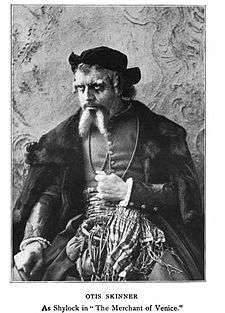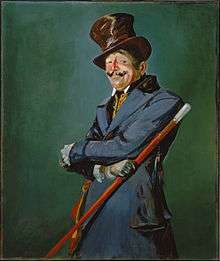Otis Skinner
Otis Skinner (June 28, 1858 – January 4, 1942) was an American stage actor active during the late nineteenth and early twentieth centuries.
Otis Skinner | |
|---|---|
Cabinet Card circa 1900–1910 NYPL Digital Gallery | |
| Born | Otis A. Skinner June 28, 1858 Cambridge, Massachusetts, U.S. |
| Died | January 4, 1942 (aged 83) New York City, New York, U.S. |
| Resting place | Woodstock, Vermont, U.S. |
| Occupation | Actor, writer |
| Spouse(s) | Maud Durbin 1895-1936 (her death) |
| Children | Cornelia Otis Skinner |
Early life
Otis A. Skinner was born on June 28, 1858, in Cambridge, Massachusetts[1] the middle of three boys raised by Charles and Cornelia Skinner. He was later brought up in Hartford, Connecticut where Charles Skinner served as a Universalist minister.[2] His older brother, Charles Montgomery Skinner, became a noted journalist and critic in New York, while his younger brother William was an artist. Skinner was educated in Hartford with an eye towards a career in commerce but a visit to the theater left him stage-struck. He secured his father's blessing for a theatrical career, and his father not only approved but also obtained from P. T. Barnum an introduction to William Pleater Davidge. Davidge employed him at eight dollars a week, and Skinner's career was launched. In the latter half of the 1870s, he played various bit roles in stock companies, and alongside stars such as John Edward McCullough. He built up his repertoire for several years in New York and Boston, including three years with Lawrence Barrett.
Career
By the mid-1880s, he was touring first with Augustin Daly, then, in 1889, with the troupe of Edwin Booth and Helena Modjeska. After that season, he played Romeo in London opposite Margaret Mather. His association with Mather lasted two years; after, with Booth dead, he returned to Modjeska, starring opposite her in her most famous roles. He also originated the role of Schwartz in Hermann Sudermann's Magda, and played Armand in Dumas's Camille.


By the mid-1890s, he was a star in his own right. In 1894, he produced and starred in Clyde Fitch's His Grace de Grammont; the same year, he performed in his brother's translation of Victor Hugo's Le roi s'amuse. In 1895 in Chicago, he succeeded as Hamlet. From 1895, he was associated with the troupe of Joseph Jefferson.
He excelled in Shakespearean roles like Shylock, Hamlet, Richard III and Romeo, and his Colonel Phillipe Brideau in The Honor of the Family was considered one of the greatest comedic performances of the first quarter of the twentieth century. Skinner's signature role was as Hajj the beggar in Kismet (1911) on Broadway, and he continued playing it on stage for twenty years, recreating his performance both in the 1920 and 1930 film versions of the play.[3]
His later roles included Albert Mott in Humpty Dumpty (1918), the title role in Sancho Panza in Melchior Lengyel's adaptation of Don Quixote (featuring Lucille Kahn in a supporting role), Sir John Falstaff in both Henry IV, part 1 (1926) and The Merry Wives of Windsor (1928), and Shylock opposite the Portia of Maude Adams (1931–32) in The Merchant of Venice.
Skinner was a successful writer whose books included Footlights and Spotlights and Mad Folk of the Theatre. In 1902, he turned Mary Hartwell Catherwood's novel Lazarre (1901) into a successful stage play.[4]
Skinner's daughter Cornelia Otis Skinner, who became an actress and writer, was born in 1899. Otis Skinner was portrayed onscreen by Charlie Ruggles in the film version of Cornelia's book Our Hearts Were Young and Gay.
He was a devout Episcopalian and a member of the Episcopal Actors Guild.[5]
Death
Otis Skinner died at his home in New York City on January 4, 1942, nearly a month after he had fallen ill while attending a benefit performance of "The Wookey" held at the Plymouth Theatre (today Gerald Schoenfeld Theatre). He had last appeared on stage in 1935, reciting the Forward in a revival of George M. Cohan's Seven Keys to Baldpate. Actress Maud Durbin, his wife for over forty years, died on Christmas Day, 1936.[6][7]
References
- Otis Skinner Dies, Famous Actor 83 - New York Times , January 5, 1942; pg. 17
- 1870 US Census records (Charles A. Skinner)
- Otis Skinner on IMDb
- Wilson, Milton L. Biography of Mary Hartwell Catherwood. Newark, Ohio: American Tribune Printery, 1904, pp.71-72,76.
- http://littlechurch.org/#/who-we-are/episcopal-actors-guild
- Otis Skinner Dies, Famous Actor 83, New York Times, January 5, 1942; pg. 17
- Mrs. Otis Skinner, Actor's Wife, Dead, New York Times, December 26, 1936; pg. 11
External links
| Wikimedia Commons has media related to Otis Skinner. |
- Otis Skinner on IMDb
- Otis Skinner at the Internet Broadway Database

- Otis Skinner portrait gallery ; University of Washington, Sayre collection
- Otis Skinner at Find a Grave
- Skinner Family papers at Houghton Library, Harvard University